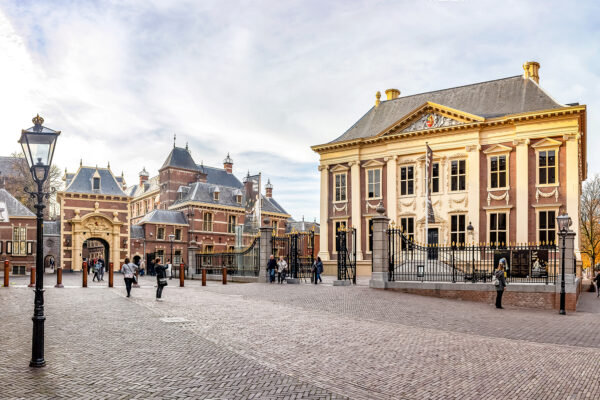
Parliamentary elections are held in the Netherlands on Wednesday. I’ll be live-blogging the results and takeaways that day. In the meantime, this explainer will get you up to speed.
Bottom lines
- Prime Minister Mark Rutte is almost certain to win reelection.
- But his center-right party would need two or three coalition partners for a majority.
- Support for most parties has been stable in the polls.
- Key issues include an overhaul of child benefits, climate and energy, housing, labor law and pension reform.
- The outgoing government’s coronavirus policy has not played a major role in the campaign.
Electoral system
The 150 members of the lower house of parliament are directly and proportionately elected to four-year terms. There is no electoral threshold.
Some 13 million Dutchmen and -women are eligible to vote. Turnout is usually between 75 and 80 percent.
Polling places opened two days early this year for those at high risk of contracting COVID-19. Voters over the age of 70 (some 2.4 million) could vote by mail. So could expats.
The upper chamber of parliament is indirectly elected by provincial deputies every four years. The most recent Senate election was in 2019. The Senate seldom dissolves before its term expires, but the lower house frequently does. Only the lower house can initiate and amend legislation.
After the election, the winning party is usually tasked by parliament (formerly the king) to form a government. Negotiations tend to last many months. The formation of Rutte’s outgoing government took 225 days, longer than any in postwar Dutch history.
The last four years
Rutte’s liberal VVD went down from 41 to 33 seats in the 2017 election but remained the largest party, followed by Geert Wilders’ Freedom Party at twenty seats.
The Christian Democrats and social-liberal D66 both gained and won nineteen seats each. Rutte tried to form a coalition with them and the Greens, who had gone up from four to fourteen seats. But those talks deadlocked.
When the parties swapped the Greens for the Christian Union, a small economically progressive but socially conservative party, they retained much of the climate policy they had negotiated with the Greens.
The ruling parties were nevertheless forced to cut emissions further in 2019, when a judge ruled that their policies fell short of EU standards. Housing developments and farm expansions were put on hold. The speed limit on Dutch highways was reduced. Rutte called it the worst political crisis of his career.
That was before COVID-19. The pandemic has killed some 16,000 people in the Netherlands. After a light lockdown in 2020, Rutte closed schools and nonessential businesses earlier this year and imposed a 9 PM curfew. Support for the government’s coronavirus policies has dropped from 67 percent a year ago to 58 percent.
Issues
Key issues in this election include: how much to regulate and tax (big) businesses; how to reform child benefits; how to meet the targets of the Paris Climate Accord, and whether to build nuclear power plants and wind turbines on land; whether to eliminate student debt; whether to reform health care; how to reduce the Netherlands’ housing shortage; how to reform labor law in order to shrink the gap between full-time employees and flex workers; and how to reform the pension system.
Click here for an overview.
Parties
Party |
Ideology |
Seats |
||
2017 |
Polls |
|||
| ■ | VVD Mark Rutte |
Liberal | 33 | 34-36 |
| ■ | PVV Geert Wilders |
Nationalist | 20 | 18-20 |
| ■ | CDA Wopke Hoekstra |
Christian democratic | 19 | 16-18 |
| ■ | D66 Sigrid Kaag |
Social-liberal | 19 | 17-19 |
| ■ | GL Jesse Klaver |
Green | 14 | 9-11 |
| ■ | SP Lilian Marijnissen |
Socialist | 14 | 10-12 |
| ■ | PvdA Lilianne Ploumen |
Labor | 9 | 11-13 |
| ■ | CU Gert-Jan Segers |
Social-Christian | 5 | 5-7 |
| ■ | PvdD Esther Ouwehand |
Animal rights | 5 | 4-6 |
| ■ | 50+ Liane den Haan |
Seniors party | 3 | 0-2 |
| ■ | Denk Farid Azarkan |
Immigrants party | 3 | 1-3 |
| ■ | SGP Kees van der Staaij |
Orthodox Calvinist | 3 | 2-4 |
| ■ | FvD Thierry Baudet |
Nationalist | 2 | 4-6 |
| ■ | JA21 Joost Eerdmans |
Liberal-conservative | 0 | 2-4 |
| ■ | Volt Laurens Dassen |
European federalist | 0 | 2-4 |
Possible coalitions
- VVD + D66 + CDA + CU: The outgoing coalition will probably defend its majority, but D66 could be wary of being the most left-wing party in a center-right government again.
- VVD + CDA + PVV + FvD + JA21: The most right-wing combination. Unlikely. The first two have ruled out a repeat of their 2010-12 pact with the far right.
- VVD + D66 + CDA + GL: Call this “Green-right”. Failed last time. D66 may want to try again in order to push the government to the left on education and the environment.
- VVD + D66 + CDA + PvdA: Would similarly give the D66 cover on the left, but every time Labor goes into government with the right as the junior party it comes out smaller.
- VVD + D66 + PvdA + GL: Called “Purple-plus”, after the 1994-2002 Purple coalitions of VVD, D66 and PvdA. Appealing to the three left-of-center parties, but risky for the VVD, which would probably lose conservative voters to the Christian Democrats and far right.
- CDA + D66 + PvdA + GL + SP + CU: “Christian-left”. The only way to form a center-left government without the VVD. A sure way for the Christian Democrats to lose the next election.
